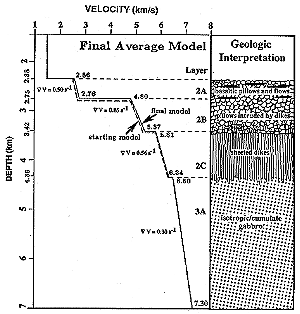A final paper prepared for Dr. Ken Creager's spring, 1996 course: Geophysics 502: Seismology
A final paper prepared for Dr. Ken Creager's spring, 1996 course: Geophysics 502: Seismology
Additional assumptions are essential to the (geomoetry of the) ray theory which governs the propagation of seismic energy in material of variable velocity and extent, but may be considered less fundamental than starting model assumptions in determining the nature of the final model and corresponding subsurface.
Cudrak and Clowes assumed they knew the geographic position of their oceanographic vessel. After all, they ultimately superimposed their conclusions about seismic velocity and associated crustal structure on seafloor topography (and geological interpretations derived from the bathymetric data). Thus, in placing their observations in a geological framework based on bathymetry, they assumed that the Sea Beam and Geological Survey of Canada data was accurate. A second spatial assumption is that the position of the 6 ocean bottom seismeters was known relative to the ship, and in turn (via the GPS latitude and longitude of the ship), known relative to the sea floor topography. The origin time of the air gun source and the timing mechanisms aboard and within the OBS were assumed synchronized and stable.
The location of the oceanographic ship was determined with integrated Loran-C and Transit Satellite Navigation, with an absolute error of +/-270 m (Loran-C only) to +/-180 m; between shot error was 15 m; between line error was 30 m. OBS locations were later altered to match water wave arrivals from proximate (2 km) shots. Some timing corrections were made, ultimately reducing most timing uncertainties to 11 ms, and water depth was calculated with a depth sounder calibrated to average northeast Pacific water column velocities.
Not only is the accuracy of modern bathymetry generally sufficient for geophysical work, but Cudrak and Clowes have gone out of their way to understand the geological and tectonic setting of their study site. In their experimental design and forward model they considered (and referenced) diverse information: large-scale topographic characterization; distribution of hydrothermal activity; Sea Beam, SeaMarcI/II, side-scan sonar, and seismic reflection data; visual observations of axial volcanism and geomorphology; and past refraction seismic research conducted in the area.
The fundamental assumptions involved in the forward model and ray theory were not only few, but carefully chosen and adjusted. The starting model was derived from previous studies in the same area (2D tomographic inversion of travel times recorded by 8 OBS deployed along the main cross-ridge line). It was tested alongside alternative models, compared with previously observed compressional wave velocity profiles representative of geographically diverse oceanic crust, and ultimately modified to include a fourth layer in response to identification of a fourth branch in Cudrak and Clowes's observed travel times.
A final inquiry might be made into why an inverse model was not utilized by Cudrak et al, especially since this study did not detect low velocity zones at depth. The choice of utilizing a relatively simple forward model (initally) may have been based on an (unmentioned) assumption that low velocity zones might be present under the Endeavour segment, and that therefore an inversion like the Herglotz-Wiechert could not be applied without "stripping off" the low-velocity layers (Lay and Wallace, p. 240).
 Based on their final model, Curdak and Clowes conclude that the
averaged velocity structure of the upper crust consists of 4 layers,
each with specific thicknesses and velocity ranges. They observe that
the layering is similar to that of normal oceanic crust and
speculate that "it is caused by large porosity contrasts due to
the distribution of fractures and vesicles and by
changes in petrology." Note, however, that the practice of
inferring petrology from seismic velocity is controversial
at this writing (
Jacobson, 1992;
Wilkens, 1991).
Based on their final model, Curdak and Clowes conclude that the
averaged velocity structure of the upper crust consists of 4 layers,
each with specific thicknesses and velocity ranges. They observe that
the layering is similar to that of normal oceanic crust and
speculate that "it is caused by large porosity contrasts due to
the distribution of fractures and vesicles and by
changes in petrology." Note, however, that the practice of
inferring petrology from seismic velocity is controversial
at this writing (
Jacobson, 1992;
Wilkens, 1991).To what extent does the final model (upon which these conclusions are based) depend on the nature of the starting model? Presumably, if the starting model happens to be a poor "guess" of the true crustal properties, the pursuant synthetic travel times would fail to match the measurements. Consequently, I find the velocity profiles, and even the petrologic sequence intuitively agreeable.
Other sources of error which might have been exacerbated by poor assumptions were addressed by the authors with care. Their methodology in general does not rouse any skepticism from me, in part because their results agree quite well with a more recent seismic reflection study of near-axis (0-4.5 Ma) upper oceanic crust (Rohr, 1994). Rohr determined the average thickness of layer 2A to be 650 m +/-300, while Curdak and Clowes calculated a thickness of 400 m.

Back to Geologic Constraints on Subsurface
Microorganisms
Outline of Geologic Constraints on
Subsurface Microorganisms